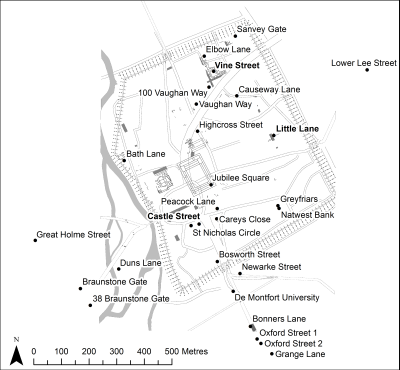
Cite this as: Cooper, N.J., Johnson, E. and Sterry, M.J. 2018 Eating In and Dining Out in Roman Leicester: Exploring pottery consumption patterns across the town and its suburbs, Internet Archaeology 50. https://doi.org/10.11141/ia.50.10
Roman Leicester, Ratae Corieltavorum, was the civitas capital of the Corieltavi tribe, who occupied the East Midlands of Britain during the Late Iron Age and Roman period. Following the Conquest in AD 43, the oppidum that was located at a crossing point on the River Soar was formally appointed as civitas capital towards the end of the first century and eventually developed into a walled town of 44.5 ha. Leicester is one of the most intensively investigated towns in Roman Britain and knowledge has benefited from a series of large-scale excavations since the late 1980s, notably in the north-east quarter of the town (Figure 1; Bidwell 2015, 117; Buckley et al. 2011; Cooper and Buckley 2003; Connor and Buckley 1999). Large quantities of pottery and other material culture relating to cuisine, as well as assemblages of animal bone and plant remains, have been analysed from these sites over three decades, allowing the broad patterns of supply and consumption to be established (e.g. from Causeway Lane: Clark 1999; Cooper 1999; Davies 1999; Gidney 1999; Monckton 1999). Some synthesis of this information has previously been published (Cooper 2007; Monckton 2004; Score et al. 2010) and the analysis of assemblages from the Highcross Shopping Centre excavations between 2003-6, and other sites in the north-east quarter, has been overviewed thematically in a volume to be published in the near future (Buckley et al. n.d.), with one chapter specifically looking at food and drink (Browning et al. n.d.). The aim of the present article is to suggest ways in which we can use these data to identify dining practices across the Roman town. This is achieved firstly by highlighting the character of three dining-related assemblages of pottery from these excavations, and secondly by analysing the quantitative data for spatial patterns of deposition, consumption and use more broadly across the town and its suburbs.

Before considering these pottery assemblages in detail it is worth discussing how we might define the character of such groups and what value can be gained by their quantified analysis. Since the 1980s quantified studies of assemblages from both urban and rural settlement sequences in Roman Britain have sought to characterise the supply and, implicitly, the use of pottery at particular times and thereby define a series of ceramic phases against which future excavated groups could be compared (e.g. Going 1987; Marney 1989; Davies et al. 1994; Cooper 1998; 2000). The intention has been to create norms similar to what coin specialists would term the British Background; the expected pattern of coin loss against which unusual occurrences can be observed and measured (Reece 1995). While subsequent work will have tended to reinforce the broad character of those ceramic phases, and the pottery specialist learns to expect what a 'typical' rubbish assemblage will look like, there is actually quite a wide range of variation within what might be regarded as such and it is difficult to define the cause of those variations. As Peña has exhaustively documented, there are numerous factors potentially contributing to the character of each assemblage, aside from the eating-related behaviours we are trying to isolate, linked to the supply and breakage rates of particular vessel types, specific activities, and issues of reuse and redeposition (Peña 2007, 319).
For the pottery specialist selecting groups to quantify in the pursuit of such behaviours, there is inevitably a trade-off between sample size, sample quality and chronological resolution. Individual context groups of less than 50 sherds might be judged too small to be statistically valid for fabric analysis, let alone analysis by vessel form (Evans 1991, 70), and the temptation is to gather together all those that belong to an occupational phase in order to create a better impression from a numerically larger sample, but this inevitably sacrifices quality. The greater the aggregation, the more that deposits from different activities, times and places within a site will be mixed, thereby lowering chronological, spatial and functional resolution, especially when contexts contain a lot of residual material; the curse of urban sequences. The use of such aggregated groups to characterise a ceramic phase therefore creates a fuzziness that might best be described as the 'background noise' of urban rubbish disposal.
The alternative, if available, is to choose a single large coherent group from each occupational phase to represent a 'snapshot' of supply and consumption at a particular time. The danger here is that such groups are not 'typical' of supply across an entire phase of 50-100 years, or are related to a specific activity or place, and therefore unrepresentative. This is because such large coherent groups are likely to represent a specific, short-lived, activity such as the clearing out of premises, for example, and are therefore closer in character to what Orton defines as the 'life assemblage' (e.g. the contents of the kitchen or shop) rather than the 'death assemblage' (the gradual accumulation of rubbish dependent upon rates of supply and breakage) (Orton 1989, 95). A good example of such a group would be the military period assemblage used to characterise supply during Ceramic Phase 1 at Roman Cirencester, considered to have been the contents of a quartermaster's store perhaps (Cooper 1998, 325, table 18 and fig. 197; Cooper 2007, 42; Rigby 1982, 179). Although the group exaggerates the proportions of fine and specialist wares that would have found their way into rubbish deposits closer in character to the 'death assemblage' (due to their lower breakage rates), it does serve to highlight the remarkable range of wares that were available to the Army, compared to the civilian settlement that succeeded it.
Providing an intriguing caveat regarding the assumption that such groups do indeed represent the clearing out of premises, Philip Carstairs has undertaken a comprehensive study of so-called 'clearance' deposits from post-medieval sites in Britain, concluding that they invariably come from cess pits (as in two of the Roman examples here), and that the pottery actually represents accumulations of ceramics, during the life of the premises, used to aid the drainage and aeration of such structures, in the same way that gardeners line flower pots with 'crocks' (Carstairs 2013, 84). This may well also apply to Roman cess pits, providing an explanation why pottery should be dumped in them so often that does not rely on the assumption they represent a closure deposit when the cess pit or related premises ceased to function.
The trade-off alluded to above can therefore perhaps be expressed most simply by considering that the 'background noise' and 'snapshot' deposits lie at opposite ends of a continuum, the former coupled with low chronological resolution and closer in character to the 'death assemblage', while the latter will have high chronological resolution and be closer to the 'life assemblage'. Within this framework, the dining-related assemblages from Leicester under consideration here would be classed as close to the 'life assemblage' and the label 'snapshot' defines them due to the brevity of the activity they represent, their association with other forms of evidence, and because their content, in terms of the proportional contribution of certain vessel types, are markedly different to what has become expected from the bulk of the deposits of pottery that make up the 'background noise'. What value does that 'background noise' have, then, short of being what we rely on to characterise activity in the absence of those undisturbed 'snapshot' assemblages? The truth is that the sheer volume of data will probably prevent the pottery specialist from appreciating that there is patterning within that highly volatile and (mostly) indecipherable background noise, which only becomes visible when we step back from the raw numbers and data tables and consider the assemblages as part of a single related dataset. For this reason, correspondence analysis can usefully be applied to these data to see if patterns emerge.
The assemblages from the north-east quarter emphasise the important role that ceramics (132K sherds), and to a lesser extent glass vessels (3172 fragments), have in reconstructing dining practice, in the absence of organic objects that have perished or metals and glass that were recycled (Table 1).
| Utensil/vessel | Vine Street | Vaughan Way | Freeschool Lane | E Bond Street | Little Lane | Sanvey Gate | Blue Boar Lane | Causeway Lane | Total |
|---|---|---|---|---|---|---|---|---|---|
| Bone spoon | 1 | - | - | - | 1 | - | 2 | 1 | 5 |
| Cu alloy spoon | 1 | - | - | - | 3 | 1 | 3 | 5 | 13 |
| Iron ladle | 1 | - | - | - | - | - | - | - | 1 |
| Knives | 6 | 1 | 1 | 1 | 1 | 37 | 47 | ||
| Whetstones | 3 | - | - | - | 12 | 2 | - | 9 | 26 |
| Quernstones | 5 | 2 | 17 | - | 7 | 31 | |||
| Shale vessels | - | - | - | - | - | - | - | 5 | 5 |
| Metal vessels | - | - | - | - | - | - | 1 | - | 1 |
| Cheese press | 2 | - | - | - | - | - | - | - | 2 |
| Pottery sherds | 30k | 2466 | 1708 | 1239 | 30k | 8k | 3k | 55k | 132k |
| Glass frags | 458 | 20 | 44 | 5 | 1637 | 101 | 230 | 677 | 3172 |
When attempting to re-create the contents of the Roman kitchen or dining room, for example, three features of Table 1 will suffice to demonstrate the impact of preservation and recycling, the first of which is the complete lack of turned wooden bowls and other utensils in wood. While no doubt dictated by the lack of waterlogged conditions in this part of the town (although none have been found by the river either), it has been argued that Roman pottery was so cheap that turned wooden vessels were not as common as in the medieval period (Mould 2011, 164-5). The fact that they must have played a large part in Iron Age dining, since pottery versions rarely occur before the conquest, and that turned shale bowls from Dorset were still in demand at Causeway Lane, would support the idea that they still figured in the 'life assemblage' even though none survive. The second is the occurrence of a single handle from a lidded bronze water jug from the second-century town house at Blue Boar Lane (a further example recently came from Friars Mill by the River Soar). Bronze jugs must have played a bigger part in the dining rooms of wealthy households at least since, as serving vessels, they were integral to the wine-drinking ritual (Cool 2006, 138-40, table 15.3; Allison n.d.), and were a way of putting distance between their owners and those who could only afford pottery flagons. Assiduous repairing and recycling of such valuable vessels evidently dictated that they rarely entered the archaeological record in Leicester. The last factor is to consider the impact of the recycling of vessel glass on the resulting assemblage. Taking the figures from Causeway Lane (Tables 2 and 3), for which we have Estimated Vessel Equivalents (EVEs) data for the entire assemblage from the Roman phases, the pottery totals 469 EVEs and the vessel glass nearly 8 EVEs, indicating that glass contributed less than 2 per cent to the combined assemblage. Glass vessels were primarily intended for the table and so if equivalent ceramic tablewares only are considered, that contribution might rise to over 5 per cent, but presumably this is far lower than their representation in the life assemblage, particularly in wealthier households.
| Site 1 | Jar | Bowl | Dish | Plate | Lid | Cup | Beaker | Flagon | Mortar | Amph | Total EVEs |
|---|---|---|---|---|---|---|---|---|---|---|---|
| Ph.2 L1st-E2nd | 66 | 18 | 1 | 4 | 2 | 4 | 3 | 1 | 0.1 | 0.1 | 14.96 |
| Ph.2 E-M2nd | 57 | 7 | 1 | 3 | 5 | 3 | 6 | 15 | 2 | 0.1 | 16.70 |
| Ph.3 M-L2nd | 47 | 11 | 7 | 2 | 2 | 8 | 7 | 14 | 3 | 1 | 26.73 |
| Ph.3 L2nd-E3rd | 50 | 11 | 9 | 1 | 1 | 8 | 5 | 13 | 1 | 0.1 | 24.54 |
| Ph.3 E-M3rd | 47 | 12 | 14 | 2 | 1 | 9 | 6 | 7 | 2 | 1 | 49.32 |
| Ph.4 L3rd-E4th | 39 | 15 | 16 | 0.1 | - | 2 | 9 | 17 | 2 | 0.1 | 26.65 |
| Ph.4 E-M4th | 49 | 20 | 12 | 0.3 | 0.1 | 1 | 9 | 0.1 | 8 | 0.1 | 18.86 |
| Total EVEs | 177.76 | ||||||||||
| Causeway Lane | Jar | Bowl | Dish | Plate | Lid | Cup | Beaker | Flagon | Mortar | Amph | Total EVEs |
| Ph.1 M-L1st | 47 | 6 | - | 12 | - | 7 | 23 | 5 | - | - | 9 |
| Ph.2 L1st-M2nd | 49 | 14 | 2 | 8 | 2 | 6 | 9 | 7 | 2 | 0.5 | 125 |
| Ph.3 M2nd-E3rd | 33 | 15 | 6 | 6 | 4 | 8 | 16 | 8 | 3 | 0.3 | 56 |
| Ph.4 M-L3rd | 40 | 11 | 18 | 0.6 | 0.4 | 9 | 13 | 2 | 6 | - | 26 |
| Ph5 L3rd-M4th | 35 | 13 | 14 | 1 | 2 | 5 | 13 | 10 | 6 | 1 | 182 |
| Ph.6 M-L4th | 33 | 12 | 25 | 0.1 | 0.7 | 3 | 10 | 5 | 10 | 0.8 | 71 |
| Total EVEs | 469 |
In contrast to the preceding Iron Age, the Roman period in Britain saw an explosion in the use of ceramics, as mass production, enabled by the wide adoption of wheel-throwing and kiln-firing, made a much wider range of vessel shapes available to ordinary people. The volume of ceramic rubbish found across the Roman town is testament to the relative ease by which broken vessels could be replaced and, by inference, the cheap unit price that must have been accorded to them. Imported samian tablewares are the only vessels that, occasionally, show signs of repair, and so even these must have been affordable to most pockets. Jars used for cooking and storage were the most common vessel type, as they had been during the Iron Age, but the repertoire was now supplemented by tablewares comprising bowls, dishes and drinking vessels, together with serving vessels such as flagons, and specialised vessels that were new to Britain such as mortaria for preparing food, and amphorae used to transport imported staples such as olive oil as well as wine, fish products and occasionally fruit such as dates.
| Site 1 | Drinking | Bowls | Jugs | Bottles | Jars etc. | Total EVEs |
|---|---|---|---|---|---|---|
| Ph.2 M1st-E2nd | - | - | 35 | 65 | - | 1.96 |
| Ph.3 M2nd-3rd | 36 | 15 | 14 | 32 | 3 | 6.40 |
| Ph.4 4th cent | 42 | 13 | 12 | 33 | - | 4.7 |
| Residual | 43 | 8 | 14 | 31 | 4 | 4.91 |
| Total EVEs | 6.30 | 1.92 | 2.78 | 6.32 | 0.37 | 17.97 |
| Causeway Lane | Drinking | Bowls | Jugs | Bottles | Jars etc. | Total EVEs |
| Ph.2 L1st-M2nd | 8 | 38 | 16 | 16 | 22 | 2.61 |
| Ph.3 M2nd-E3rd | 49 | - | 9 | 42 | - | 1.64 |
| Ph.5 L3rd-M4th | 55 | 16* | 23 | 6 | - | 3.64 |
| Total EVEs | 3.0 | 1.6 | 1.4 | 1.32 | 0.57 | 7.89 |
Looking at the contribution of pottery in detail, the excavation of stratified sequences across the Roman period in Leicester allows us to trace the changing contribution of different vessel types over time. Table 2 presents phase group data spanning the first to fourth centuries CE from Vine Street (Johnson 2009a, 35, tables 2-38, figs 40-47) and from Causeway Lane (Clark 1999, tables 9-28), while Table 3 presents vessel glass data from those sites for comparison (Cool 2009b, 278, table 120). The pottery data from both sequences have been simplified in graphical form (Figure 2 and Figure 3) to illustrate the varying contribution of the four major vessel categories; jars, dishes and bowls, drinking vessels, and flagons, with mortaria, amphorae and lids grouped under 'other vessels'. To give a longer sequence, the Vine Street pottery data have been supplemented by the mid-first century Conquest-period group from Bath Lane (Merlin Works) and the mid- to late fourth-century group from Freeschool Lane (Johnson 2009b; 2011). All the assemblages were quantified by sherd count, weight and EVEs (Estimated Vessel Equivalents using the percentage of rim present), the EVEs data being presented here (with the exception of the Bath Lane and Freeschool Lane groups, expressed by percentage of sherds) as the most objective way of measuring the comparative contribution of different vessel types in large, coherent groups, although it does tend to over-represent narrow-mouthed vessels such as flagons. It is perhaps worth noting here that two of the authors (NJC and EJ), after many years of worrying about it, are happy that all three quantification methods used here produce broadly comparable results, and that pragmatically (if not theoretically) it is valid to present data from different methods together (cf. Evans 1991, 72).
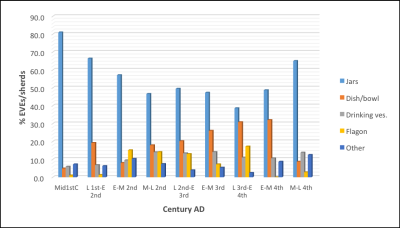
Figures 2 and 3 illustrate that jars contribute 80 per cent to the Conquest-period assemblage at Bath Lane but that the sequence at both Vine Street and Causeway Lane indicates a dramatic drop in the dominance of the jar, down to below 50 per cent during the second and third centuries, with a low of 33 per cent, coupled with signs of a resurgence among fourth-century groups at Vine Street and Freeschool Lane. Bowls and dishes, suitable for serving and eating food, as well as for certain methods of cooking, show a corresponding rise across the period, from 5 per cent in the mid-first century to over 30 per cent by the fourth century and, within that trend, there is a move away from shallow platters by the later first century towards dishes and bowls. The occurrence of drinking vessels similarly rises from 5 per cent at the Conquest (with an abnormally high level of 30 per cent within a small group from Causeway Lane) to levels of between 13 per cent and 24 per cent during the second and third centuries, declining to as low as 10 per cent during the fourth, probably because of the increased availability of free-blown glass drinking vessels (Table 3). The trend for flagons tends to mirror that for drinking vessels, rising to as high as 17 per cent in the second to early fourth centuries and declining sharply thereafter. Amphorae routinely contribute less than 1 per cent and are probably not imported after the early third century, while mortaria tend to contribute less than 3 per cent before the mid-third century, rising to between 6 per cent and 10 per cent in the later third and fourth-century groups. Considering briefly the trends in vessel glass over the same period, there is a distinct shift from the storage and serving of liquids in jugs and bottles and the serving of food in bowls, towards a greater emphasis on drinking vessels, as commonly seen at other sites in Roman Britain (Cool 2006, 224, table 19.1 and fig. 19.1).
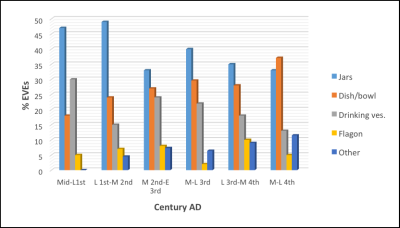
Within Leicester, then, figures for individual ceramic vessel categories will vary at the same date in different sequences but the broad trends in vessel use over time are fairly consistent and in line with other urban assemblages in Britain, for example from Verulamium (St Albans), Colchester and Alcester (Evans 2001, 29-31; Doherty 2013). The contrast with contemporary rural assemblages is that while they will often possess the same range of vessel types as their urban counterparts, they will continue to be jar-dominated – in some cases all other vessel types contributing as little as 10 to 20 per cent combined, the figure rising for villas and small towns (e.g. Cooper 2007, 44, figs 4.4a and b, for comparative fabric supply data).
This section looks at two case-studies where 'snapshot' deposits of ceramics are associated with specific buildings and food remains, suggesting that they had a specialised function related to eating and drinking outside the household. The first is from the fill of a cellar, which perhaps lay below a tavern on Little Lane, containing tablewares, drinking vessels, amphorae and flagons, alongside animal bones and oysters. The second is the fill of a cess pit from Castle Street containing amphorae, flagons, tableware bowls and dishes, but no drinking vessels, alongside exotic plant foods, fish and smoked shoulders of beef, and is considered to relate to a 'delicatessen'-style 'take-away'.
Structure 8 on Little Lane, excavated in 1988 in advance of the Shires shopping centre, was the remains of a timber-lined cellar, belonging to a building fronting on to the east side of the street, and constructed in the middle of the second century (Lucas and Buckley 2007, 29, fig. 19, Phase 5.6/6.3 Feature 186; Sawday 1989, 32-35). The date of the pottery indicates that the building above was demolished and the cellar backfilled soon afterwards, probably between 160 and 180, and certainly no later than 200 CE (Pollard 2007, 213). A remarkable assemblage of over 5600 sherds of pottery (163kg, 173 EVEs with high average sherd weight of 29g), was retrieved from the backfill, alongside animal bone representing the main domesticates and some wild species (Gidney 2007, 449), and large numbers of discarded oyster shells (Monckton 2007, 481). The plant remains were sparse except for a scatter of cereal remains including wheat grains, probably spelt.
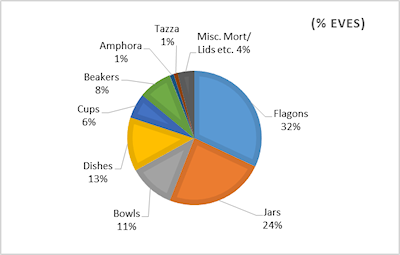
The pottery assemblage (Table 4, Figure 4) contained a very high proportion of white-ware flagons (over 30 per cent by EVEs) when compared to the contemporary phase groups from Vine Street and Causeway Lane, while the proportion of bowls, dishes and drinking vessels are actually as expected, with jars being markedly lower. Amphorae contribute an expected 1 per cent and comprise at least five of Dressel 20 (olive oil) from southern Spain and one of Gauloise 4 (wine) from southern Gaul, with sherds of Dressel 2-4 (wine), Cam 186 (fish sauce) and the basal spike of a 'carrot' amphora Cam 189, thought to transport dates, all of which are possibly residual in this context (Pollard 2007, 213-20). Imported Gallic samian tablewares (the data for which are incorporated into Table 4), contribute 14 per cent, which is about what might be expected at this date in Leicester, and included 27 decorated bowls and 30 stamped vessels, together with an unusually large proportion of cups, mainly of Form 33, with about one-third as many Form 27s, all of which show a degree of wear on their foot rings (6 per cent). Whether these samian cups were used for drinking or as mixing bowls for sauces on the table, is a matter of debate (Dannell 2006, 158), but additionally, the assemblage contained many bag-shaped beakers (8 per cent) with clay roughcast, roulette and en barbotine figural decoration, made locally in orange fabrics and, further afield, with dark colour-coats from the Lower Nene Valley and Cologne, alongside handled mugs made in BB1 (black burnished ware category one) from South-East Dorset. The most unusual occurrence was that of the so-called 'tazze' (1 per cent), the conventional term used among Roman pottery specialists in Britain for frilled rim bowls popularly considered to be incense burners. There were also a significant number of jugs and drinking vessels in glass from the cellar fill (Monk 2007, 382), perhaps indicating an establishment of some class.
| Little Lane Cellar Phase 6.3 F186 c. 160-180 | ||
|---|---|---|
| Form | EVEs | % EVEs |
| Flagons | 56.05 | 32 |
| Jars | 40.73 | 24 |
| Bowls | 19.48 | 11 |
| Dishes | 22.54 | 13 |
| Cups | 9.76 | 6 |
| Beakers | 13.96 | 8 |
| Amphora | 1.78 | 1 |
| Tazza | 2.14 | 1 |
| Misc. Mort/Lids etc. | 6.85 | 4 |
| Total | 173.29 | 100 |
The oysters had been opened on the premises as triangular notches, caused by inserting a pointed knife blade between the valves and twisting, were apparent on many, usually directly opposite the hinge. The oysters were then presumably presented for consumption inside the cupped valve, on dishes, perhaps. However, the fact that there are 25 per cent less cupped valves than flat ones, would indicate that some oysters were eaten off the premises, as take-away items. Mussels and a small number of whelks were also consumed on the premises. According to Apicius (Edwards 1993), sauces popularly served with oysters contained wine, olive oil and fish sauce, which might therefore explain the presence of the relevant amphorae, although the small number of those for transporting wine may not accord with the numbers of drinking vessels, if that was the beverage being consumed. The presence of large numbers of drinking vessels sets this assemblage apart from the proposed delicatessen at Castle Street, described below and, in conjunction with the large numbers of oysters imported from the east coast, suggests the remains of a tavern, selling snacks alongside alcohol, to be consumed on the premises (see Figure 5), as paralleled by the Room 4 frontage in Insula XIV at Verulamium where a large deposit of oyster shells was also found (Frere 1972, 12).
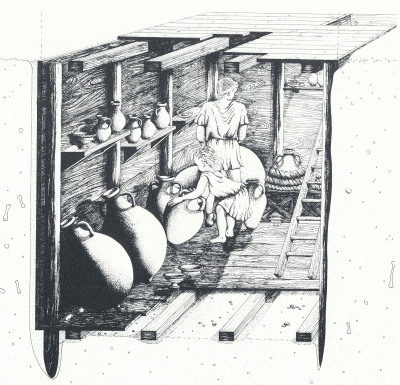
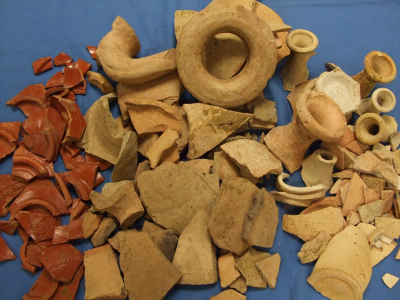
Excavations at the junction of Castle Street and 72 St Nicholas' Circle (Score et al. 2010, 78) revealed a colonnaded shop front facing east on to the main street, to the south of the forum, behind which was a cess pit (Pit 1067) containing evidence to suggest that one of the shops had been the Roman equivalent of a delicatessen, selling meat, fish, fruit and wine during the middle of the second century. Conditions in the cess pit allowed for the mineralisation of an exceptional range of seeds including exotic imports, alongside an unusual assemblage of animal bone and pottery that would not be found in a domestic rubbish deposit (Figure 6).
| Form | Sherds | % Sherds | Weight (g) | % Weight |
|---|---|---|---|---|
| Amphora | 94 | 20.0% | 10184 | 51.5% |
| Bowl/Dish | 60 | 12.8% | 1616 | 8.2% |
| Flagon | 156 | 33.3% | 4035 | 20.4% |
| Jar | 145 | 30.9% | 3627 | 18.3% |
| Mortarium | 6 | 1.3% | 282 | 1.4% |
| Plate/Platter | 8 | 1.7% | 49 | 0.2% |
| Total | 469 | 100.0% | 19793 | 100.0% |
The assemblage of 469 classifiable sherds (20kg), of later first to mid-second century date, comprised a higher proportion of amphorae (20 per cent) and flagons (33 per cent) than found in contemporary deposits on Vine Street and Causeway Lane (Table 5, Figure 7). The amphora types comprised Dressel 20, Gauloise 4, Dressel 2-4, Cam 186 and Fishbourne 148.3, representing at least six vessels; Baetican Dressel 20 olive oil and Gaulish Gauloise 4 wine amphorae are the most common types found in Leicester. The Dressel 2-4 wine amphora is most likely to have come from Italy, and the Cam 186 (Cadiz fabric) is thought to be used for transporting fish sauces (Peacock and Williams 1986, Class 17). The source of the Fishbourne 148.3 amphora is unknown, although it may be related to the Cam 189 'carrot' amphora, which has been associated with the transport of fruit such as dates (Peacock and Williams 1986, Class 12). The average sherd weight of 42g is exaggerated by the presence of these bulky amphorae, but even without them the figure is a respectable 26g, supporting the contention that this is a primary deposit. At least 17 flagons, including devolved ring-necked and two-handled collared forms, are represented from sources such as Mancetter-Hartshill, Northamptonshire and Verulamium. In addition, 77 per cent of the bowls, dishes, plates and platters are imported samian tablewares from Southern and Central Gaul, representing at least 26 vessels. The forms present include Drag. 15/17, 18, 18/31, 18/31R, 79, 30, 37 and Curle 11, ranging in date from the late first century through to the middle of the second century. Significantly, however, in contrast to the cellar group from Little Lane, there is a complete absence of samian cup forms Drag. 27 and 33 or, indeed, cups or drinking beakers in any other ware.

The preserved plant foods included grape pips, apple pips, stones of small plum or bullace, seeds of wild strawberry and figs and a single seed of opium poppy, which was used both medicinally and as a food flavouring. The animal bone assemblage of 198 fragments included the remains of 16 adult cattle scapulae, all butchered in a distinct manner and with a hole through the blade, used to suspend the shoulder during the drying or smoking process (Cool 2006, 89). Oblique knife cuts on the scapulae suggested that the cured or smoked beef was sliced off the bone. Both pig and sheep skull fragments were recovered from the pit as well as other meat-bearing sheep bones, and the assemblage also included domestic fowl. The fact that all parts of the carcass were being exploited raises the possibility that products for which we have no direct evidence, such as sausages and blood pudding, were also being sold on the premises. The environmental samples produced a small number of fish bones and scales, among which eel was identified, as well as a few bones that may belong to herring (Score et al. 2010, 89).
In summary, the pottery indicates the presence of imported olive oil, wine and preserves transported in amphorae, but probably decanted into the flagons for sale, while the presence of samian dishes and bowls, but not cups, or beakers in other wares, would suggest the presentation of items for sale rather than the consumption of food and beverages on the premises. The botanical evidence demonstrates the importation and introduction of a range of fruit and seeds that may also have been sold on the premises, while the faunal remains indicate the sale of smoked or cured beef carved off the bone and fish, both freshwater and marine, perhaps preserved in salt or prepared as a sauce.
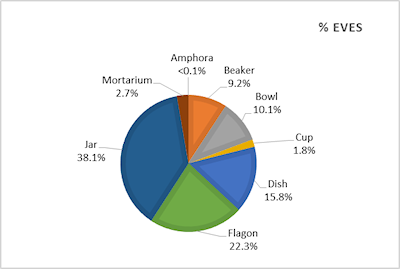
The room at the southern end of the west range of the Vine Street courtyard house, when it was at its height of sophistication, was identified as a kitchen (Higgins et al. 2009, 102) owing to the presence of hearths and a drain, and traces of cereals accumulated on the floors detected by micromorphological analysis of the soil (MacPhail and Crowther 2009, 514). An impression of the contents of the kitchen, and some of the food cooked there is provided by two deposits dating to the later third and into the mid-fourth century. The first of these is the fill of two cess pits G526 dating to the later third or early fourth century (Table 6 and Figure 8), and the second is the fill of the kitchen drain G1004 from the time when it was being reused as a culvert for the workshop, which had taken over the kitchen space when the house was in decline by the middle of the fourth century. The cess pits contained a range of pottery vessels dating to the later third century, together with a variety of exotic food remains unlike any from the earlier phases of the site.
| Form | Sherds | % Sherds | Weight (g) | % Weight | EVEs | % EVEs |
|---|---|---|---|---|---|---|
| Amphora | 9 | 1.8% | 901 | 4.0% | 0 | 0.0% |
| Beaker | 35 | 7.0% | 586 | 2.6% | 1.875 | 9.2% |
| Bowl | 40 | 8.0% | 1781 | 7.9% | 2.07 | 10.1% |
| Cup | 5 | 1.0% | 38 | 0.2% | 0.36 | 1.8% |
| Dish | 42 | 8.4% | 2918 | 12.9% | 3.245 | 15.8% |
| Flagon | 89 | 17.8% | 2445 | 10.8% | 4.575 | 22.3% |
| Jar | 261 | 52.1% | 8351 | 37.0% | 7.815 | 38.1% |
| Mortarium | 20 | 4.0% | 5520 | 24.5% | 0.55 | 2.7% |
| Total | 501 | 100.0% | 22540 | 100.0% | 20.49 | 100.0% |
The pottery from the cess pits comprised colour-coated ware beakers and flagons together with a wide range of cooking vessels in black burnished ware 1 from south-east Dorset, including at least 12 cooking pots, 9 plain rimmed dishes and a number of flanged bowls. Four of the cooking pots had soot deposits on their exterior surface, together with limescale on their interiors, while the dishes were generally large (260mm and 280mm in diameter) with sagging bases (Figure 9). This type of base makes the vessel less appropriate for flat surfaces but may have been intended to sit in the ashes of a hearth or perhaps on a brazier, and recalls the convex bases of a specialised casserole used in North Africa, designed to sit on a brazier, and made briefly in York in the first decade of the third century, when the African emperor Septimius Severus was in residence (Cool 2006, 40, and fig. 6.1). This vessel type, which was more suitable than a cooking pot for cooking dishes having a drier texture (Cool 2006, 39), might have been particularly useful. Certainly dishes of this diameter and larger (over 300mm) generally become more popular from the later third century onwards (Holbrook and Bidwell 1991, 100) and probably point to the growth of a more communal style of eating, whereby individuals could more easily help themselves to portions placed centrally on a table. This suggests a form of 'commensalism', which was probably becoming more widespread with the rise of Christianity in the fourth century, and has been detectable in the evolution of dish forms in African red slip ware, the successor to samian across much of the Western Empire, small amounts of which come to Britain (e.g. Tyers 1996, 152, fig. 177.23). The pottery vessels found lining the workshop drain G1004 were presumably those used in the kitchen at the end of its life and included a similar range of BB1 cooking pots, bowls and dishes to that from the cess pits, together with the more gracile, reeded-rim mortaria from Mancetter-Hartshill and large indented beakers from the Lower Nene Valley (Figure 9).

The conditions in the cess pits had allowed for the mineralisation of a range of plant remains comprising numerous fruit stones of sloe, bullace, plum, cherry and apple from one, and fig and opium poppy seeds from the other (Monckton and Radini 2009, 370). Both pits also contained evidence of spelt wheat grains and cereal cleaning waste as well as abundant remains in the form of bones and scales of both freshwater and marine fish, including herring, eel, smelt, perch and small cyprinids such as bream and grayling. While evidence of chewing showed that many of these small bones had passed through the gut, of particular note was the occurrence of the remains of the skeleton of a barbel with an estimated length of 460mm, indicating table waste of an elite nature. A group of oyster shells from the cesspit were noticeably larger than those from other sites in the town, and the presence of diagnostic infestations indicated that some may have derived from the south coast rather than the usual east coast source previously identified (Hill 2009, 490). Animal remains included a cattle scapula with a suspension hole from a cured or smoked shoulder of beef of the kind for sale at the delicatessen in Castle Street, described above (Browning 2009, 433). The implication that the household could afford to buy a whole shoulder, rather than a few slices of beef, is another measure of their likely wealth. Other species from the site, but not specifically from the deposit, included roe deer, red deer, hare, domestic fowl and goose.
Besides the large-scale excavations in the town, there have been numerous other interventions over the last three decades that have generated pottery assemblages varying in size from thousands of sherds (e.g. early phases at Vine Street) down to less than a hundred (e.g. Duns Lane), and within which quality will inevitably vary. The aim of this last section is to analyse data from 26 of these assemblages, dating broadly between the mid- to late first and later second centuries CE when activity was most intense in Leicester and rubbish disposal at its highest level. Using data in spread-sheets supplied by University of Leicester Archaeological Services (ULAS), about 6000 vessels were identified by form and fabric within these 26 assemblages, using the vessel classes already described. Fabric groups were simplified into generalised local (e.g. grey wares), regional (e.g. BB1 and colour-coated wares) and imported (fine) (e.g. samian and amphorae) sources of supply, in order to create 23 discrete fabric/form categories (Data table [.xls]). Vessel numbers are based on spread-sheet row counts (of a single sherd or sherd family). Estimated Vessel Equivalents (EVEs) data are unsuitable as these are not whole numbers. Since little is known of Roman pottery production within the local hinterland of Leicester (c. 15 mile radius), the distinction between local and regional categories is arbitrary in some cases, but not significant (see Cooper 2004, fig. 3). The assemblages were analysed using the ade4 software package in R (an open source programming language and software environment for statistical computing and graphics) to conduct a spatial Correspondence Analysis (sCA) (Chessel et al. 2004; Dray and Dufour 2007; see also Sterry, this volume (for a fuller discussion of its potential use with archaeological material). This is similar to a standard correspondence analysis (e.g. Baxter 1994; Cool and Baxter 1999), but spatial information is included via a spatial weighting matrix.
There are two elements to the results that should be read together. Firstly, the bi-plots generated by the SCA(Figure 10a and Figure 10b [SVG]) should be read such that the origin represents 'the average profile' and that locations away from this represent 'departures away from the average' (Shennan 1997, 321). The axes themselves represent part of the chi-squared distance between row profiles (in this case the different site assemblages). Points that plot together should share some similar characteristics, while points that are diametrically opposed should have dissimilar characteristics. In the spatial visualisations (Figure 11a and 11b), the axes scores are used to generate colours; in all cases, sites and locations with similar colours should have similar characteristics because they plot near to each other on the bi-plot, hence they can be read intuitively. In the visualisation of a single axis, using a divergent colour scheme generated with colorbrewer 2.0 (Axis Maps 2013), the axis scores are interpolated using a simple inverse distance-weighted method. In the visualisation of the two axes (Figure 12), the colour of each site symbol represents the direction from the origin on the bi-plot and the size of the symbol represents its distance from the origin.
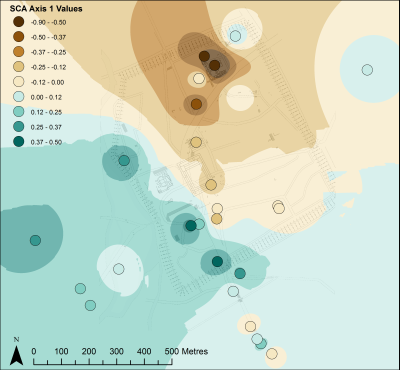
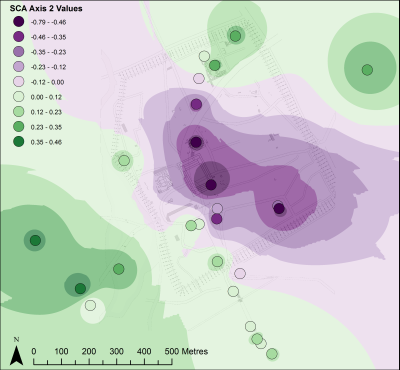
The results of the spatial Correspondence Analysis suggest that there is a strong spatial structure to the assemblages in both the first and second axes. In the first axis (Figure 11a), sites from within the (later) enclosed area of the town, tend to more negative values, especially in the north-east quarter, while sites along the waterfront and in the western and southern suburbs (as well as Lower Lee Street to the east) tend to more positive values. In the second axis (Figure 11b), the central part of the town has more negative values, while the more peripheral parts, and the suburbs, have more positive values. This implies that we should be able to distinguish between assemblages, firstly from the central part of the town around the forum/basilica and macellum, secondly, from the residential parts, particularly the town houses in the north-east quarter, and lastly from the waterfront and the suburbs.
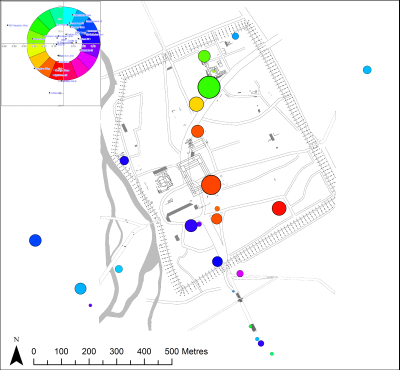
Defining the character of these assemblages in terms of vessel types is perhaps less straightforward. On the first axis, flagons and dishes (negative) are opposed by amphorae and platters (positive) with local vessels mostly central and no clear groupings for cups, beakers and bowls. On the second axis, imported (classed here as 'fine') vessels (negative) are largely opposed by regional vessels (positive) with local vessels again fairly central to the plot. Vessel types that occur commonly in all assemblages of this date range, such as local jars, regional flagons and imported cups and dishes in samian ware, tend to cluster around the origin, while platters and amphorae will denote sites of earlier date, opposing regional bowls and dishes that do not become common until the later first and second century. Outliers such as local flagons, imported (fine) jars and flagons only occur in small numbers.
How can these variations be interpreted? It is considered that the visualisation of Axis 1 is likely to be an expression of the chronological variation within the 26 assemblages; the waterfront and river crossing, centring on the location of the oppidum, have greater numbers of earlier vessels (first century CE) and those further away, that develop once the street grid is in place, have greater numbers of later vessels (second century CE). Referring to the data presented earlier (Figure 2 and Figure 3), the changes to the vessel repertoire are quite rapid during the second half of the first century and the second century, and so this would not be a surprising explanation. While it may not help distinguish different contemporary table habits, it does give some insight into how the city developed, as well as emphasising how chronologically sensitive dining practices can be across a 150-year period.
The second axis perhaps contains more useful information. It suggests that there are some differences in depositional practice between the civic centre around the forum and the more residential parts of the settlement. For example, consumption patterns and depositional practices relating to rubbish collection and disposal, as well as vessel curation, may have differed markedly between the shops and taverns closer to the centre and the town houses towards the periphery. As evidenced by the 'snapshot' groups detailed above, such variations clearly existed and, but for the intervening two millennia of urban growth and consequent disturbance, would be far more widespread and obvious to us today.
This study has enabled the publication of two previously unavailable 'snapshot' assemblages and their associated plant and animal evidence, and the exposure of another such assemblage to a wider audience. There is no doubting the importance of publishing such groups so that we can start to discuss eating and drinking, which was on everybody's mind at the time, rather than just pots, which probably never entered the consciousness of most people! The application of spatial Correspondence Analysis to a large body of data has allowed a preliminary appreciation of the potential for looking at town-wide trends that could easily be transferred to other urban centres with digital pottery archives, and will no doubt in time become standard practice. It has demonstrated that there is meaningful patterning in the assemblages from Leicester that goes beyond a generic 'background noise' that might otherwise be ignored. It is a potential starting point from which to consider zonation and differentiation within an urban context, and further chronological refinement of the datasets will no doubt lead to greater clarity. In addition, there are large numbers of rural settlement assemblages from the hinterland of Leicester, from farmsteads, villas and small towns that will allow us to advance our understanding of the urban/rural divide more coherently than is currently possible (Cooper 2007, 41).
Internet Archaeology is an open access journal based in the Department of Archaeology, University of York. Except where otherwise noted, content from this work may be used under the terms of the Creative Commons Attribution 3.0 (CC BY) Unported licence, which permits unrestricted use, distribution, and reproduction in any medium, provided that attribution to the author(s), the title of the work, the Internet Archaeology journal and the relevant URL/DOI are given.
Terms and Conditions | Legal Statements | Privacy Policy | Cookies Policy | Citing Internet Archaeology
Internet Archaeology content is preserved for the long term with the Archaeology Data Service. Help sustain and support open access publication by donating to our Open Access Archaeology Fund.